Connect With Us
Blog
Items filtered by date: January 2024
Diagnosis of Stress Fractures
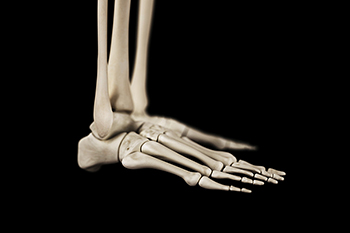
A foot stress fracture is a microscopic crack in the bone, often caused by repetitive stress or overuse. This common injury can affect various bones in the foot, such as the metatarsals, and typically emerges gradually due to activities such as running or jumping. Recognizing the symptoms is vital, as persistent pain, swelling, and tenderness are common indicators. To diagnose a foot stress fracture, podiatrists employ a combination of clinical evaluation and imaging studies. X-rays may not immediately reveal the fracture, but MRI imaging or bone scans may offer more detailed insights. Medical history, physical examination, and a thorough discussion of the individual's activities contribute to an accurate diagnosis. Early detection is essential for effective management, often involving rest, modified activity, and sometimes bracing or casting. If you have foot pain, and believe it may be a stress fracture, it is suggested that you visit a podiatrist who can accurately diagnose and treat this condition.
Stress fractures occur when there is a tiny crack within a bone. To learn more, contact Dr. Harry I. Zirna from Lockport Foot Care, PLLC. Dr. Zirna can provide the care you need to keep you pain free and on your feet.
How Are They Caused?
Stress fractures are the result of repetitive force being placed on the bone. Since the lower leg and feet often carry most of the body’s weight, stress fractures are likely to occur in these areas. If you rush into a new exercise, you are more likely to develop a stress fracture since you are starting too much, too soon. Pain resulting from stress fractures may go unnoticed at first, however it may start to worsen over time.
Risk Factors
- Gender – They are more commonly found in women compared to men.
- Foot Problems – People with unusual arches in their feet are more likely to develop stress fractures.
- Certain Sports – Dancers, gymnasts, tennis players, runners, and basketball players are more likely to develop stress fractures.
- Lack of Nutrients – A lack of vitamin D and calcium may weaken the bones and make you more prone to stress fractures
- Weak Bones – Osteoporosis can weaken the bones therefore resulting in stress fractures
Stress fractures do not always heal properly, so it is important that you seek help from a podiatrist if you suspect you may have one. Ignoring your stress fracture may cause it to worsen, and you may develop chronic pain as well as additional fractures.
If you have any questions, please feel free to contact our offices located in Lockport, NY . We offer the newest diagnostic and treatment technologies for all your foot care needs.
Causes of Blackened Toenails
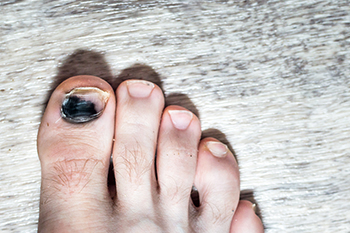
Blackened toenails are caused by repetitive pressure and friction, often occurring when the toe is forced against the front edge of a shoe's toe box. While sometimes referred to as tennis toe, blackened toenails can also affect athletes in soccer, football, squash, racquetball, basketball, running, and skiing. Symptoms include throbbing pain and a reddish-blue or black discoloration of the nail plate due to a subungual hematoma, which is caused by blood under the nail. The big toe is more commonly affected in blackened toenails, but the second toe may also be affected. Wearing ill-fitting shoes plays a pivotal role, causing friction that leads to bleeding under the toenail. In severe cases with significant bleeding, swelling, or infection, visiting a podiatrist is suggested. This foot doctor may relieve pressure on the subungual hematoma by making a small hole in the nail or, in extreme cases, recommend partial or complete nail removal. Prevention involves wearing well-fitted shoes and recognizing early symptoms. Whether you are an avid athlete or enjoy an active lifestyle, if you notice discoloration in the toenails, it is suggested that you schedule an appointment with a podiatrist for treatment solutions.
Toe pain can disrupt your daily activities. If you have any concerns, contact Dr. Harry I. Zirna of Lockport Foot Care, PLLC. Dr. Zirna can provide the care you need to keep you pain-free and on your feet.
What Causes Toe Pain?
Most severe toe pain is caused due to a sports injury, trauma from dropping something heavy on the toe, or bumping into something rigid. Other problems can develop over time for various reasons.
Toe pain can be caused by one or more ailments. The most common include:
- Trauma
- Sports injury
- Wearing shoes that are too tight
- Arthritis
- Gout
- Corns and calluses
- Hammertoe
- Bunions
- Blisters
- Ingrown toenails
- Sprains
- Fractures (broken bones)
- Dislocations
When to See a Podiatrist
- Severe pain
- Persistent pain that lasts more than a week
- Signs of infection
- Continued swelling
- Pain that prevents walking
Diagnosis
In many cases the cause of toe pain is obvious, but in others, a podiatrist may want to use more advanced methods to determine the problem. These can range from simple visual inspections and sensation tests to X-rays and MRI scans. Prior medical history, family medical history, and any recent physical traumatic events will all be taken into consideration for a proper diagnosis.
Treatment
Treatments for toe pain and injuries vary and may include shoe inserts, padding, taping, medicines, injections, and in some cases, surgery. If you believe that you have broken a toe, please see a podiatrist as soon as possible.
If you have any questions please feel free to contact our offices located in Lockport, NY . We offer the newest diagnostic tools and technology to treat your foot and ankle needs.
Heel Pain Can Be Treated!
Ways to Reduce Pain From High Heels
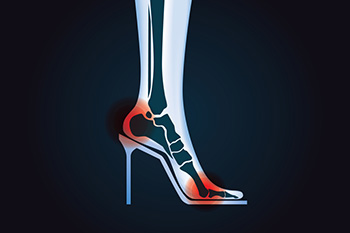
Walking in high heels can exude confidence and style, but it often comes at the expense of comfort. To navigate the world of stilettos without enduring pain, consider a few essential tips. First, choose heels with a reasonable height and platform, allowing for better weight distribution. Prioritize proper shoe size to avoid unnecessary pressure on toes and insteps. Engage core muscles for improved balance, maintaining an upright posture to alleviate strain on the lower back. Mastering a heel-to-toe walking technique ensures a smoother gait, reducing impact on the feet. Take smaller steps and embrace a slower pace to enhance stability and grace. Additionally, opt for shoes with cushioned insoles or consider using gel inserts for added comfort. Gradual practice in heels at home can help build endurance and confidence. Lastly, pamper your feet with stretches and massages. If you would like more information about how to wear high heels while protecting the feet, it is suggested that you confer with a podiatrist.
High heels have a history of causing foot and ankle problems. If you have any concerns about your feet or ankles, contact Dr. Harry I. Zirna from Lockport Foot Care, PLLC. Dr. Zirna can provide the care you need to keep you pain-free and on your feet.
Effects of High Heels on the Feet
High heels are popular shoes among women because of their many styles and societal appeal. Despite this, high heels can still cause many health problems if worn too frequently.
Which Parts of My Body Will Be Affected by High Heels?
- Ankle Joints
- Achilles Tendon – May shorten and stiffen with prolonged wear
- Balls of the Feet
- Knees – Heels cause the knees to bend constantly, creating stress on them
- Back – They decrease the spine’s ability to absorb shock, which may lead to back pain. The vertebrae of the lower back may compress.
What Kinds of Foot Problems Can Develop from Wearing High Heels?
- Corns
- Calluses
- Hammertoe
- Bunions
- Morton’s Neuroma
- Plantar Fasciitis
How Can I Still Wear High Heels and Maintain Foot Health?
If you want to wear high heeled shoes, make sure that you are not wearing them every day, as this will help prevent long term physical problems. Try wearing thicker heels as opposed to stilettos to distribute weight more evenly across the feet. Always make sure you are wearing the proper shoes for the right occasion, such as sneakers for exercising. If you walk to work, try carrying your heels with you and changing into them once you arrive at work. Adding inserts to your heels can help cushion your feet and absorb shock. Full foot inserts or metatarsal pads are available.
If you have any questions please feel free to contact our offices located in Lockport, NY . We offer the newest diagnostic and treatment technologies for all your foot and ankle needs.
Causes of Numbness in the Feet
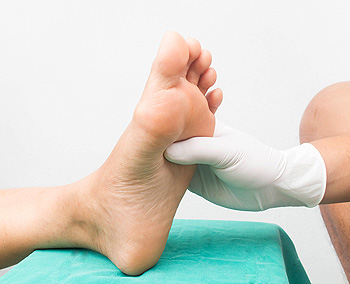
Numb feet, characterized by diminished sensation, often arises from simple factors like nerve compression due to awkward sitting or tight shoes. However, persistent numbness, or neuropathy, can signal serious underlying health concerns. Numbness in the feet typically accompanies sensations such as pain, burning, or tingling, collectively known as paraesthesia. If left untreated, the numbness may progress to weakness and reduced foot control. The causes can be broadly categorized into nerve damage and diminished blood supply. Nerve damage disrupts communication between sensory nerves and the brain, leading to numbness. This breakdown prevents the interpretation of pressure and temperature stimuli. Pins and needles sensations arise when signals are erratic. Causes of nerve damage include temporary nerve compression, where prolonged awkward sitting or tight shoes reduce oxygen and nutrient flow to nerves, resulting in temporary numbness and subsequent pins and needles upon movement. Peripheral neuropathy involves damaged peripheral nerves unable to transmit signals to the central nervous system. It can lead to persistent numbness and is associated with conditions such as diabetes, systemic diseases, and alcoholism. If you experience numbness in the feet frequently, or for long periods, it is suggested that you schedule an appointment with a podiatrist for a full examination and treatment options.
Neuropathy
Neuropathy can be a potentially serious condition, especially if it is left undiagnosed. If you have any concerns that you may be experiencing nerve loss in your feet, consult with Dr. Harry I. Zirna from Lockport Foot Care, PLLC. Dr. Zirna will assess your condition and provide you with quality foot and ankle treatment for neuropathy.
What Is Neuropathy?
Neuropathy is a condition that leads to damage to the nerves in the body. Peripheral neuropathy, or neuropathy that affects your peripheral nervous system, usually occurs in the feet. Neuropathy can be triggered by a number of different causes. Such causes include diabetes, infections, cancers, disorders, and toxic substances.
Symptoms of Neuropathy Include:
- Numbness
- Sensation loss
- Prickling and tingling sensations
- Throbbing, freezing, burning pains
- Muscle weakness
Those with diabetes are at serious risk due to being unable to feel an ulcer on their feet. Diabetics usually also suffer from poor blood circulation. This can lead to the wound not healing, infections occurring, and the limb may have to be amputated.
Treatment
To treat neuropathy in the foot, podiatrists will first diagnose the cause of the neuropathy. Figuring out the underlying cause of the neuropathy will allow the podiatrist to prescribe the best treatment, whether it be caused by diabetes, toxic substance exposure, infection, etc. If the nerve has not died, then it’s possible that sensation may be able to return to the foot.
Pain medication may be issued for pain. Electrical nerve stimulation can be used to stimulate nerves. If the neuropathy is caused from pressure on the nerves, then surgery may be necessary.
If you have any questions, please feel free to contact our offices located in Lockport, NY . We offer the newest diagnostic and treatment technologies for all your foot care needs.
Adult Flat Feet and Their Underlying Causes
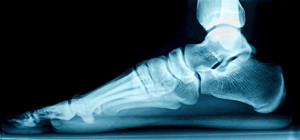
Adult flat feet, a condition where the arches of the feet collapse, can be attributed to a multitude of factors, each contributing to the intricate landscape of this common ailment. One primary cause is weakened or overstretched tendons, often stemming from prolonged wear and tear or injury. Age-related changes to tendons and ligaments can also impact foot structure, leading to the development of flat feet. Genetic predispositions often play a role, as individuals with a family history of flat feet may be more susceptible. Certain medical conditions, such as arthritis, diabetes, or obesity, contribute to altered foot mechanics and increased stress on the arches. Pregnancy is another factor, with hormonal changes and increased weight-bearing influencing foot structure. Wearing unsupportive footwear, especially during critical developmental stages, can contribute to the prevalence of adult flat feet. If you have flat feet, it is suggested that you visit a podiatrist who can offer you relief techniques, which may include custom-made orthotics.
Flatfoot is a condition many people suffer from. If you have flat feet, contact Dr. Harry I. Zirna from Lockport Foot Care, PLLC. Dr. Zirna will treat your foot and ankle needs.
What Are Flat Feet?
Flatfoot is a condition in which the arch of the foot is depressed and the sole of the foot is almost completely in contact with the ground. About 20-30% of the population generally has flat feet because their arches never formed during growth.
Conditions & Problems:
Having flat feet makes it difficult to run or walk because of the stress placed on the ankles.
Alignment – The general alignment of your legs can be disrupted, because the ankles move inward which can cause major discomfort.
Knees – If you have complications with your knees, flat feet can be a contributor to arthritis in that area.
Symptoms
- Pain around the heel or arch area
- Trouble standing on the tip toe
- Swelling around the inside of the ankle
- Flat look to one or both feet
- Having your shoes feel uneven when worn
Treatment
If you are experiencing pain and stress on the foot you may weaken the posterior tibial tendon, which runs around the inside of the ankle.
If you have any questions please feel free to contact our offices located in Lockport, NY . We offer the newest diagnostic and treatment technologies for all your foot and ankle needs.
Blog Archives
- March 2024
- February 2024
- January 2024
- December 2023
- November 2023
- October 2023
- September 2023
- August 2023
- July 2023
- June 2023
- May 2023
- April 2023
- March 2023
- February 2023
- January 2023
- December 2022
- November 2022
- October 2022
- September 2022
- August 2022
- July 2022
- June 2022
- May 2022
- April 2022
- March 2022
- February 2022
- January 2022
- December 2021
- November 2021
- October 2021
- September 2021
- August 2021
- July 2021
- June 2021
- May 2021
- April 2021
- March 2021
- February 2021
- January 2021
- December 2020
- November 2020
- October 2020
- September 2020
- August 2020
- July 2020
- June 2020
- May 2020
- April 2020
- March 2020
- February 2020
- January 2020
- December 2019
- November 2019
- October 2019
- September 2019
- August 2019
- July 2019
- June 2019
- May 2019
- April 2019
- March 2019
- February 2019
- January 2019
- December 2018
- November 2018
- October 2018
- September 2018
- August 2018
- July 2018
- June 2018
- May 2018
- April 2018
- March 2018
- February 2018
- January 2018
- December 2017
- November 2017
- October 2017
- September 2017
- August 2017
- July 2017
- June 2017
- May 2017
- April 2017
- March 2017
- February 2017
- January 2017
- December 2016
- November 2016
- October 2016
- September 2016
- August 2016
- July 2016
- June 2016
- May 2016
- April 2016

